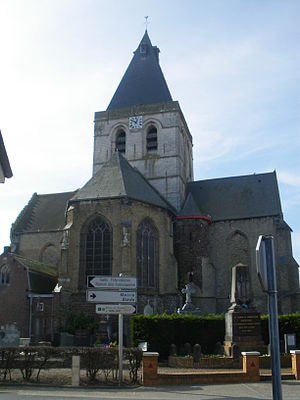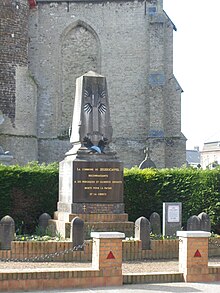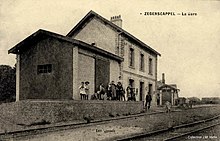Zegerscappel
| Zegerscappel | ||
|---|---|---|

|
|
|
| region | Hauts-de-France | |
| Department | North | |
| Arrondissement | Dunkerque | |
| Canton | Wormhout | |
| Community association | Hauts de Flandre | |
| Coordinates | 50 ° 53 ' N , 2 ° 23' E | |
| height | 7-40 m | |
| surface | 17.4 km 2 | |
| Residents | 1,529 (January 1, 2017) | |
| Population density | 88 inhabitants / km 2 | |
| Post Code | 49470 | |
| INSEE code | 59666 | |
| Website | http://www.zegerscappel.fr/ | |
 Saint-Omer church |
||
Zegerscappel , West Flemish Zegerskapelle is a French commune with 1,529 inhabitants (at January 1, 2017) in Nord in the region of Hauts-de-France . It belongs to the Arrondissement of Dunkerque and the municipality of Hauts de Flandre . West Flemish is also spoken in Zegerscappel .
geography
The municipality of Zegerscappel is located in French Flanders in the far north of France, about 20 kilometers southeast of Dunkirk and thus in the immediate hinterland of the Channel coast . The flat area of the municipality is traversed by the Yser in a west-east direction. The forestless landscape is characterized by fields and meadows.
In addition to the closed settlement image of the core town, the hamlets of La Cloche and La Tranquilité are located in the municipality of Zegerscappel .
Neighboring communities of Zegerscappel are Crochte in the north, Esquelbecq in the east, Ledringhem in the southeast, Arnèke in the south, Bollezeele in the southwest and Eringhem in the west.
history
In a document from the Abbey of Loppem (municipality of Zedelgem in Belgium) the place was first mentioned in 1119 as Siegri Capella . The Flemish name can be with winners chapel or winning Chapel freely translate.
The place name changed from Sygeri Capelle in 1199 via Zeghers Capelle (1245), Sigicapella (1251), Sohiercappel (1298), Soyerecapple (1302), Zoiiercapele (1327), Zeghers Capple (1552) and Segherscappele (1628) to Zeggers Cappel in 1861. The Zegerscappel form has been official since 1971 .
The Templars established observation posts in the plain on the old Roman road between Mardyck , Steene and Cassel - including at the Yser crossing near today's Zegerscappel. The fortified posts served to defend themselves against the Normans who, following the coastal rivers, had plundered the inland since the 9th century. Defense towers, fortified churches and abbeys gradually emerged from the fortified posts. Remains of such fortifications can still be found in Zegerscappel.
At the place of a victory over the Normans, a chapel was built - namesake and nucleus of the community. The chapel became a church in the 12th century, which was destroyed by the Geusen in 1585 and restored from 1614 to 1633. An underground connecting passage dating from the time of the Templars was discovered between the church and an old mansion, which is still called the temple courtyard today .
With the completion of the Esquelbecq station building , Zegerscappel got a rail connection on the Arras - Dunkirk line in 1864 .
Population development
| year | 1962 | 1968 | 1975 | 1982 | 1990 | 1999 | 2007 | 2017 | |
| Residents | 1193 | 1202 | 1208 | 1179 | 1252 | 1202 | 1493 | 1529 | |
| Sources: Cassini and INSEE | |||||||||
Culture and sights
Buildings
- Church of St. Audomar ( Église Saint-Omer ), originally a 12th century chapel, destroyed by the Geusen in 1585 and restored from 1614 to 1633, Monument historique
- Chapel of St. Bonaventure ( Chapelle Saint-Bonaventure )
- Sacred Heart Chapel of St. Bonaventure ( Chapelle du Sacré-Cœur )
- Burial Chapel of Our Lady of Lourdes ( Chapelle mortuaire Notre-Dame-de-Lourdes )
- Former house of the justice of the peace ( Maison dite Ancienne justice de paix ), Monument historique * Monument to the fallen
folklore
In Zegerscappel, as in other places in northern France and Belgium, there is the tradition of giant processions ( Géants ). The giants can be seen at Carnival time, on the last weekend in April and at many other regional festivals. In 2006 the European Festival of Giants took place in Steenvoorde . Since 2005, the performances have been carried out by UNESCO under the title Processions of Giants and Dragons from Belgium and France as masterpieces of the oral and intangible heritage of humanity . The Géant figure by Zegerscappel is “Klakke van zes Kappel”, a 4.20 m high and 38 kg heavy giant doll that is carried by one person.
Economy and Infrastructure
Agriculture still plays an important role in Zegerscappel. There are 44 farms in the municipality (cultivation of grain, vegetables and pulses, cattle and poultry farming). The beans grown here are known nationwide.
There is a connection to the Autoroute A25 ( Dunkerque - Lille ) ( Wormhout junction ) five kilometers east of Zegerskappel . From Zegerscappel there are road connections to Saint-Omer , Socx , Eringhem and Wormhout. Halfway between Zegerscappel and Esquelbecq, Esquelbecq station is on the Arras to Dunkirk railway line .
literature
- Le Patrimoine des Communes du Nord. Flohic Editions, Volume 2, Paris 2001, ISBN 2-84234-119-8 , pp. 1771-1772.
supporting documents
- ↑ history www.zegerscappel.fr. Archived from the original on July 12, 2013 ; Retrieved February 24, 2013 (French).
- ↑ Zegerscappel on cassini.ehess.fr
- ↑ Zegerscappel on insee.fr
- ^ Entry in the Base Mérimée of the Ministry of Culture. Retrieved February 23, 2013 (French).
- ^ Entry in the Base Mérimée of the Ministry of Culture. Retrieved February 23, 2013 (French).
- ↑ Klakke van zes Kappel on lesgeants.skyrock.com
- ↑ Farms on annuaire-mairie.fr (French)


